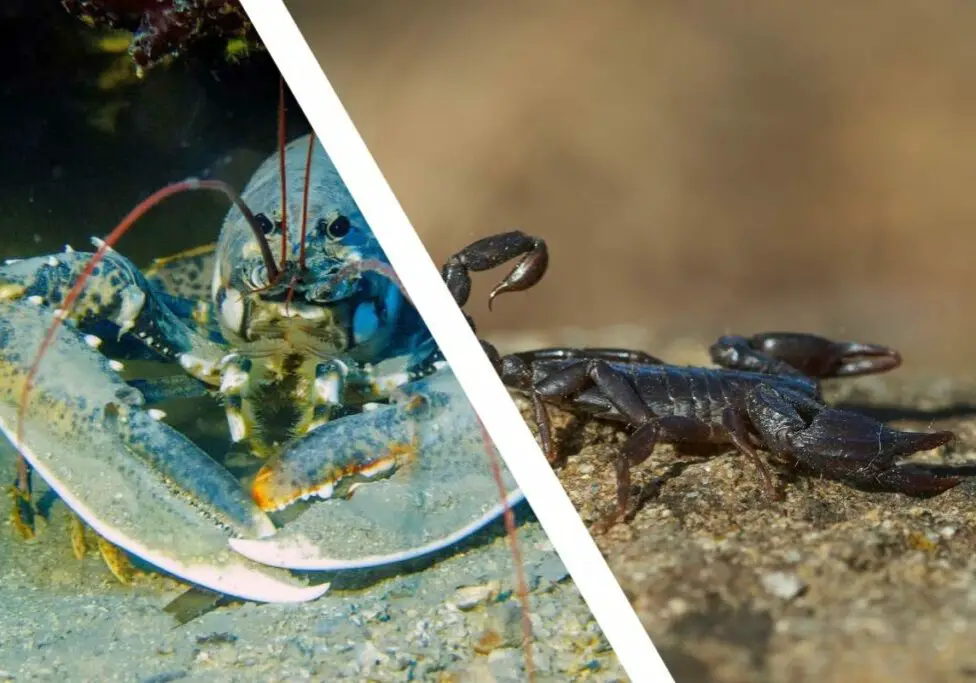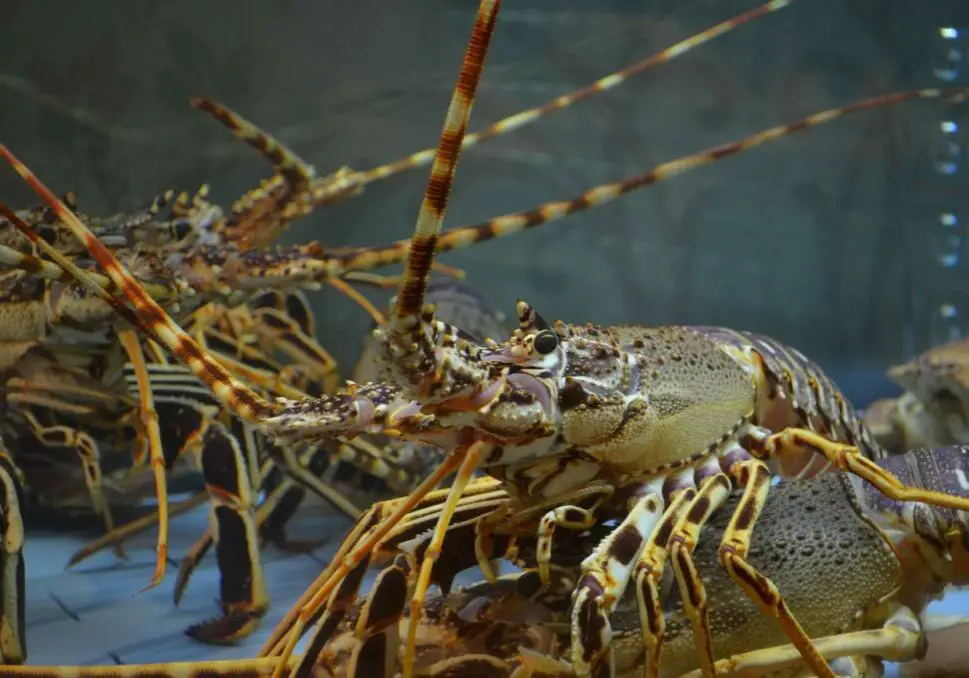How Do Lobsters Communicate? (It’s Disgusting!)
It’s fascinating how other animals interact because very often, the way of communication is much different than in humans or other mammals. We can, of course, communicate by speaking or even writing, but some animals use other unique techniques. If you wonder how lobsters communicate underwater, in this blog post, we’ll talk all about that. However, let’s begin with a quick answer:
Lobsters communicate by spraying themselves with chemical substances that are in their urine. In other words – they pee on each other. They also use other ways of communication, such as making buzzing sounds or fighting with each other.
However, this certainly doesn’t tell the whole story. Below I’ll explain more about how lobsters communicate with their urine and why they do that. Furthermore, I’ll explain what messages they communicate and what other ways they collaborate. Read on!
How do lobsters communicate?
Animals developed many different ways of communication, such as making sounds, touching each other, or producing chemicals. We can say that lobsters fall into the third category because they communicate by peeing on each other, or in other words spraying their chemicals 😉
These colorful creatures have two bladders located on both sides of their head. Right under their eyes, they have two urine release nozzles with which they spray urine at other lobsters they want to communicate with. Next, the sprayed lobster absorbs the urinary chemicals by the olfactory (“smelling”) pathways and translates the smell into a message.
The chemicals that lobsters’ urine consists of are called pheromones. They basically work like hormones outside of the body and can be smelled by other lobsters. The smell can differ depending on what the lobster wants to communicate. Sometimes it can be a message about aggression or attraction which we’ll talk more about below.
Why do lobsters use urine for communication?
When you think about ways of communication, your first natural thought is probably a voice. So, let’s first answer the question, why don’t lobsters just use a voice to communicate with each other? Unlike humans or some marine animals, lobsters don’t have any vocal cords. As consequence, they aren’t able to produce any sounds verbally, so this method of communication is not an option for lobsters.
Lobsters found other communication technique which is very efficient in their case. And this is the main reason – efficiency. But, what makes it efficient? When lobsters squirt their urine, the chemicals can go even seven lobster lengths away! This way, lobsters can definitely communicate their message if other lobsters are not too far away.
What do they communicate with their chemicals?
It’s important to know that lobsters are highly territorial animals. They establish a hierarchy of dominance within their community through lobster fights. These fights can be pretty brutal and can end up with missing body parts, such as claws or eyeballs. Once they establish their social order, the dominant male in the society will mate first.
To show affection
The winning lobster will have urine that smells differently than the losing lobster, smelling more attractive to females. The winner is awarded the first pick of the batch with females. When ready, it shoots urine in the female direction.
If the female likes the smell, it gets closer and approaches the male’s burrow. Next, of course, she will pee on his face to show she’s interested as well and ready to mate. This behavior also makes the male less aggressive.
After the male lets the female move into his burrow, they start several-day foreplay during which they stroke each other with antennae and with feet covered in taste receptors. Next, the female slowly sheds her hard shell and the pouch where she had banked sperm from a previous mate.
This leaves her with only a soft shell which is why the strongest male is there to protect her. Next, the male suspends himself above the female and lifts her to face him, cradling her in his legs. He puts a packet of his sperm into her new sperm pouch, using his appendages, called gonopods.
After the mating event, the female is allowed to remain in the male’s shelter for up to two weeks. After that, she must leave, allowing the next female in the area to mate with the dominant male as well. During this mating period, the female’s urine is sending signals to other females that the male has coupled up.
As you can see, one of the lobsters’ reasons for communicating is to show affection. Males are informing females they like them and attract them with the smell. Females, however, respond to it, and also by doing that, they minimize aggression in the male.
To show dominance
Another “message” lobsters send to each other is to show their dominance. In general, they don’t really get along. If lobsters come into each others’ territories, then they probably are going to fight. They do this for the best shelters and for the best mating rights.
Once the dominant lobster is chosen, sometimes it needs to remind others of their hierarchy. To inform them about its social status and show aggression, it’ll pee on their faces. We can say that dogs also mark their territories with their urine. However, to show aggression they mostly show their teeth. Lobsters don’t have teeth, so they either use the urine or immediately start the fight.
Other ways in which lobsters communicate
These fascinating species also developed other strategies to communicate. While spraying the urine is the most common, there are a few others to connect with other lobsters.
Communicating with sound
As I mentioned above, none of the lobster species have vocal cords and produce any sounds. However, some lobsters can produce sounds by rubbing their antennas together. The rapid contraction of internal muscles located at the base of their antennas causes their carapaces to vibrate.
As a result, it produces a low-frequency sound analogous to the ‘buzzing’ sound. But, because this sound has a narrow bandwidth, only organisms capable of perceiving sounds in the same band of frequencies might hear it as well.
Interestingly, when lobsters produce the “buzzing” sound, others can hear it even when located a few miles away. Below you can listen to the sound of spiny lobster:
Why do lobsters communicate with sound?
We’re still not sure what the exact purpose of this sound is. However, some scientists assume that it is mainly to deter potential predators. During one of the experiments, American lobsters started creating the sound when they approached two species of fish in the tank: cod and striped bass, which are their predators.
Another way how lobsters can supposedly use their buzzing sounds is to show their presence and mark their territory. During an experiment, two lobsters attacked the hydrophone – a microphone designed to listen to and record underwater sounds. Right before the attack, the lobsters’ sounds were recorded.
Lobsters are known to be very territorial species living in burrows, similar to those of mantis shrimp. The buzzing sounds might help them to send signals about their presence to other co-species, in addition to chemical cues, to maintain their territory. Similar behavior was also observed with mantis shrimp.
Lobsters may also produce sounds to recall the outcome of past male encounters. The chemical signals can preserve the memory of the outcome between lobsters. However, if the male produces the sound it can recall the hierarchy in order to avoid additional fights and lower the risk of injury.
Interestingly, as some researchers say, this may be just the beginning of the wide research area. We still don’t know a lot about the oceans and their species, so definitely many sound-producing animals remain to be discovered.
Communicating by fighting
As I already mentioned, lobsters establish their position through their fights. This is also a way of communication to present their dominance. They don’t argue, vote, or discuss it as we would probably do. During the fight, they usually use their antennas and claws if this is the species that has them.
After the winner “communicated” his dominance, he gets the burrow and the right to mate. Below you can see a video showing lobster’s fight:
Can lobsters hear?
This is a crucial factor determining whether lobsters can even hear others’ sounds. They don’t have ears, but scientists say that lobsters have structures all over their bodies called hairfans, which can detect the vibrations made by other lobsters, such as screeching, rasping, or vibrating.
The research in 2021 showed that lobsters detect sounds below 250 Hz with the best sensitivity between 80 and 120 Hz, a range that encompasses the fundamental frequency of their buzzing sounds. However, we still need more research about their exact hearing sensitivity as the communication distances might be much shorter than the detection ranges.
Scientists were able to detect sounds kilometres away underwater with hydrophones. They predict that in lobsters case, assuming that they’re sensitive to frequencies below 1 kHz, the communication distances would be no more than 10 m.
Sources
- Jézéquel, Youenn & Bonnel, Julien & Coston-Guarini, Jennifer & Guarini, Jean-Marc & Chauvaud, Laurent. (2018). Sound characterization of the European lobster Homarus gammarus (L.) in tanks. Aquatic Biology. 27. 13-23. 10.3354/ab00692.
- Youenn Jézéquel, Ian T. Jones, Julien Bonnel, Laurent Chauvaud, Jelle Atema, T. Aran Mooney; Sound detection by the American lobster (Homarus americanus). J Exp Biol 15 March 2021; 224 (6): jeb240747. doi: https://doi.org/10.1242/jeb.240747
You may also like:

Welcome to Bubbly Diver!
I’m glad to see you here. This blog is created for all marine creature lovers by a bubbly diver - me, Dori :)


